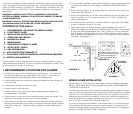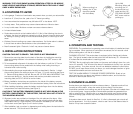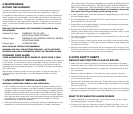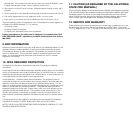
alternate exit. If the inside of the door is cool, place your shoulder against it, open
it slightly and be ready to slam it shut if heat and smoke rush in.
•Stay close to the floor if the air is smoky. Breathe shallowly through a cloth, wet if
possible.
•Once outside, go to your selected meeting place and make sure everyone is there.
•Call the fire department from your neighbor’s home - not from yours!
• Don’t return to your home until the fire officials say that it is all right to do so.
There are situations where a smoke alarm may not be effective to protect against fire
as stated in the NFPA Standard 72. For instance:
a) smoking in bed
b) leaving children home alone
c) cleaning with flammable liquids, such as gasoline
Further information on fire safety can be obtained in a pamphlet titled “IN A
FIRE SECONDS COUNT” published by the NFPA, Batterymarch Park, Quincy,
MA 02269
9.NRC INFORMATION
Ionization type smoke alarms use a very small amount of a radioactive element in the
sensing chamber to enable detection of visible and invisible combustion products.
The radioactive element is safely contained in the chamber and requires no adjust-
ments or maintenance. This smoke alarm meets or exceeds all government stan-
dards. It is manufactured and distributed under license from the U.S. Nuclear
Regulatory Commission.
10. NFPA REQUIRED PROTECTION
The National Fire Protection Association’s Standard 72 provides the following
information:
Smoke alarms shall be installed outside each separate sleeping area in the immediate
vicinity of the bedrooms and on each additional story of the family living unit, including
basements and excluding crawl spaces and unfinished attics. In new construction, a
smoke alarm also shall be installed in each sleeping room.
Smoke Detection - Are More Smoke Alarms Desirable? The required number of
smoke alarms might not provide reliable early warning protection for those areas sep-
arated by a door from the areas protected by the required smoke alarms. For this
reason, it is recommended that the householder consider the use of additional smoke
alarms for those areas for increased protection. The additional areas include the
basement, bedrooms, dining room, furnace room, utility room, and hallways not pro-
tected by the required smoke alarms. The installation of the smoke alarms in the
kitchen, attic (finished or unfinished), or garage is normally not recommended, as
these locations occasionally experience conditions that can result in improper opera-
tion.
This equipment should be installed in accordance with the National Fire Protection
Association’s Standard 72 (NFPA, Batterymarch Park, Quincy, MA 02269).
NOTIFY YOUR LOCAL FIRE DEPARTMENT AND INSURANCE COMPANY OF YOUR
SMOKE ALARM INSTALLATION.
11. CAUTION (AS REQUIRED BY THE CALIFORNIA
STATE FIRE MARSHAL)
“Early warning fire detection is best achieved by the installation of fire detection equipment
in all rooms and areas of the household as follows. A smoke alarm installed in each sepa-
rate sleeping area (in the vicinity of, but outside of the bedrooms), and heat or smoke
alarms in the living rooms, dining rooms, bedrooms, kitchens, hallways, attics, furnace
rooms, closets, utility and storage rooms, basements and attached garages.”
12. SERVICE AND WARRANTY
If after reviewing this manual you feel that your smoke alarm is defective in any way,
do not tamper with the unit. Return it for servicing to: KIDDE Safety, 1394 South
Third St., Mebane, NC 27302. 1-800-880-6788 (See Warranty for in-warranty returns)








